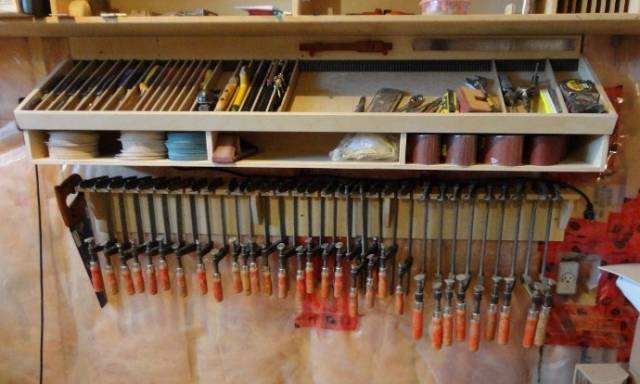
Mike40
in over 11 years
HOW DO YOU CARRY OUT YOUR PROJECTS?
I know we all work differently and often our work flow is based on different priorities. I thought it might be interesting to compare notes just for fun. While there must be certain logical ways to operate as a professional for the sake of efficiency and profitability we hobbyists can work in whatever way suits us. I don’t believe there is a right or wrong way for us, just the most fun way, unless of course you are not enjoying the work and/or the results. I will stick my neck out and go first. Please don’t follow my example. It is just the way I enjoy working and there is certainly nothing smart about it!
I work in a very undisciplined way. I’m not at all concerned with productivity and I don’t really care how long my projects last (except before Christmas).
I normally make a crude sketch, usually on graph paper if proportions are an issue and often with just a side or front view and I write on the width and length or other measurements I deem critical. From my rough sketch I do a rough estimate of materials and I often add 10% for waste. I do try to select the best pieces or planks I can find. I check to see where it came out of tree, for imperfections and warpage when that is an issue and I try to imagine based on my design what bad parts if any can be cut out without too much wastage
On dimensioned and planed materials I go to rough cutting the lengths and widths I need and then machine or hand plane to final dimensions. Next comes the joinery work. I like to do this with hand tools if there isn’t too much, but I’m all for using power tools to avoid actual work.
I try to get as much out of machine set-ups as possible, so Its good whenever different parts can have similar dimensions widths or thicknesses to reduce wasted time to reset machines. I try to get as many parts through one set-up before changing for different cuts
I try to get the stuff required for the next step joined, sanded and glued-up first so it can be ready the following day or sometime just an hour or so later so I don’t get too many glue-ups at once and I don’t impede the work. I often change details as I work. I like to do this because seeing partly constructed pieces stimulates me to make design and construction improvements.
I usually don’t clean up much while I’m working on a project. My shop gets dusty with lots of cut-offs and tools laying around. Please do not follow my example!
How do you carry out your projects with regard to:
- Planning
- Purchasing materials, quantity, quality, etc.
- figuring out the work flow
- setting up your machines
- Glue-ups
- keeping your workshop organized and clean underway
I’m not planning on changing my way of woodworking no matter how good someones else’s way is, but I am wondering if there are wide differences between us or just small ones.
Mike, an American living in Norway
21 Replies
Thanks for describing you way of doing things Mike .
I have my way also when I build a project when the size does not matter .
To begin with I look through my material stock and chose what I think will work as far as wood species and grain is concerned to go with the idea /design I have in my head and seldom do I make a sketch and the design and size sort of develop and change as I go along or I may have a piece of certain wood that want’s to be something .
On projects like cabinets where size is critical I make a cutting list and sometimes make a story stick as a reference and that works great for me .
On a curved stair which I don’t build anymore if I can help it as it is hard work I used to make a full size drawing on plywood sheets laying on the floor and all parts would be referenced of it using radius rods and line transfer tools etc. that way I was sure that the stair would go together right and the final size of the stair would fit in the location .
As far as my tools are concerned they are a mix of power and hand tools and when working at the bench I like to keep tools of the bench as much as possible and put them back in my slanted tool rack above the bench which works great for me . The table saw is my main work horse and then there are all the other power tools getting their turn as required .
One thing I like to practice is to keep the shop cleaned up and organized which I think is very important .
Other then that I just try not to get stressed and have a good time in the shop and not plan ahead as things always change anyway just go with the flow .
Klaus
Mike,
This is a pretty typical break-down of my working style.
1. Spend a few years of sleepless night thinking about projects and planning the joinery and building it in my head. (This sometimes includes years of convincing my husband to let me do it.)
2. Start to work on a SketchUp for it. That generally ends up being a few more years.
3. Dig through the pile of lumber to try to find the best pieces for the project. This step is my most disliked one.
4. Plane what I hope will be more than enough board feet to finish the project.
5. Sort through the planed lumber repeatedly while reviewing my cut list to try to get the least waste, then rough cut the lengths and widths. This is another forever step.
6. Attempt to do all similar set-ups at the same time, if possible. . . planing, sanding, sawing, routing, drilling, etc.
7. Build the carcass first.
8. When making drawers:
a. Plane all the lumber for the boxes.
b. Cut it to exact dimensions.
c. Stack drawer sides in sets and complete each one before going on to the next.
d. Dovetail one set at a time.
e. Route the grooves for the bottom.
f. Cut the bottom plywood to size.
g. Dry fit.
h. Glue up.
9. If the project is large, I often do the finishing in sections.
In between each of these steps, is more planning and building in my head during sleepless nights. I’m always rethinking how to achieve the end result.
These steps get jumbled when life gets in the way and I forget where I was by the time I get back to the project.
I try to somewhat keep up with organizing the shop throughout the project, but often fail. When I finally finish the project, I try to do a thorough cleaning/organizing of the shop for the next project.
L/W
“Those who would give up essential Liberty, to purchase a little temporary Safety, deserve neither Liberty nor Safety.” Benjamin Franklin
Thanks for your response. I hope others will join in too.
Klaus Your approach is the most organized and far more professional than mine. This undoubtedly comes from your orderly mind and many years of professional stair building (I hope I got that last part right, just assuming from your comments, please correct me if I’m wrong). It is the right way to work. When we had a visit from an American friend of mine who owned a furniture factory before retiring and he was appalled that I didn’t clean up after a work session in my shop. Truth is I just like to get as much work done within the time constraints and/or I get too tired to clean up at the end of the day. Neither excuse is a point of pride.
L/W I too have my project in my mind constantly and when I go to bed, and I often solve a lot of project problems or make decisions about them between bedtime and the following morning. I used to use Sketchup a lot, but In most cases I think it takes far too much time, so I have not been using it much the last few years. That said, it is a wonderful tool and I would use it more if I could do so with greater speed.
Mike, an American living in Norway
Good morning Mike
The most important thing I have learned is to put tools back where they belong which is not always easy but it saves a lot of time and keeps down frustration .The tool tray above my bench has done wonders .This is a picture when I first built it and now the work bech is below it and the clamps have moved over to the right and the tools have been rearranged and added to several times .
This was actually published in a WOOD MAGAZINE issue three years ago .

I have wood and hardware stashed in boxes and on shelf’s all over the place and in no particular order but I usually know what I have and where it is .
I don’t profess to be a clean freak but I have three garbage can’s in different locations and that makes it convenient .
The thing that bothers me the most is the fine dust and that is something that I mean to address more as a dust collector and air filter have not done a good enough job and a air to air heat exchanger may be the way to go as it will exhaust the dust and keep the heat loss to a acceptable level and the other issue is the collection of dust at the source which is something I have played with for years and I am getting closer with this problem on my table saw .
I could go on and on but it is a big subject and I will never have a shop like these pristine looking shops that seem to be a show piece but seldom get worked in that would take all the fun out of it for me as I prefer to design and build .
Klaus
Good topic Mike
Planning and working is a bit of a mix for me,it will differ depending on if it’s a job for myself or a customer. Customer work I tend to try and firm up the design and dimensions and get approval of both before I start work. Then I may go as far as making a prototype or make a full-scale drawing. Of course I have to acquire wood ,hardware and any finishes I don’t have before I start. When planning a good size project I do give it a lot of thought before,during and after as to the correct joinery to use and logical order in which to build. Selecting wood is always time-consuming to get the proper grain matching an plan arond defects .Depending on the scale of the project I may produce a cut list.After a few days in the shop and the wood has acclimated I rough cut it to size and let in acclimate some more just to make that I’m not going to have any crazy wood movement. I then plan my approach as to minumize set up time on whatever machinery I’m going to use. As I proceed I try and clean up after myself as I go but not always depending on how close my delivery date is. If feel it’s safer to no have things under foot to trip on.
On my own projects I seldom purchase material,since I have a shop full of wood or make elaborate cut list or drawings and work on them when I can.
All said and done I guess my process is not that different from your 1-6 list you posted Mike.
I have often wondered how Klaus has come up with his diverse and great projects other than his great creative skill ,now reading that he wants to see what the wood want’s to be helps me understand a little better. I think I will try and adapt that approach for my own personal builds and perhaps I can be a little more creative and use up some of the wood that fills every corner of my shop.
All of you have that have posted I really like and admire you great projects.
woodworking classes, custom furniture maker
Thanks for you contributions guys.
I really do wish I could work neater and clean up after each work day. One big problem I have is that my shop is so small that clean up is really stressful to me. I have to move all of my machines as I progress. The job takes a lot of time and effort which I tend to shy away from. Keeping my tools orderly are not really a problem for me as I keep them pretty well organized and stored. I do always clean up before starting a new project, but the mess can be left a few days before that happens.
Like you guys I do not place a lot of weight on shop aesthetics. Reasonably good tool and wood storage and proper machine placement with adequate benches and counter tops is a lot more important to me. I do like an orderly appearance, but have no need for anything fancy.
However, I can understand some folks desire and/or need to have an attractive shop, as I know that a clean, beautiful, well lighted work space can be more inspiring for many folks. When my own shop is all cleaned up I feel much more encouraged to get out there and do something.
Otherwise it does sound like we all work in a somewhat similar manner when it comes to the work process. I hope we get some comments from someone who has a totally different approach from the ‘norm’.
Mike, an American living in Norway
Interesting read, never really thought this through, before.
Planning
Depends on the complexity of the project. The larger it is, the more in depth my drawing(s) will be, although simple projects I very seldom do drawings. Sometimes the planning stage includes researching, to see what might be the best way to do something, or for inspirational ideas. I very seldom build from plans, although I buy books and magazines, for ideas.
Purchasing materials, quantity, quality, etc.
Most times, materials are purchased without any projects in mind. I keep my eyes open for wood, and other bits that might be useful, and buy and stash them. Some would I’ve had for years. When buying for a specific project, I usually by more than needed, so I have extra. You know how it works, “I cut it twice, and it’s still too short!” :-)
figuring out the work flow
Hmmmm. That just seems to come to mind. After a number of years in the shop, I have an idea of what has to be done before other steps. At the same time, I’m usually working on more than one project, so when one comes to a stall, I jump to something else.
setting up your machines
My only machine that is semi-permanently set up, is my small table saw. Everything else stays shelved, until I need it.
Glue-ups
When necessary. :-) I don’t glue up panels, these days, as I don’t have many good clamps. I tend to work on smaller projects, or those that I can use good plywood.
Keeping your workshop organized and clean underway
Oh, this is a tough one for me. I live my life in ordered chaos, with most everything in levels of disarray. I can’t seem to keep a clear work surface. My table is 4’ by 16’ and it stays covered, most the time, until I clear it for another session. :-(
Keith "Shin" Schindler
Usually a project stay in my head for a while.
I “stare” at it until I think I figured everything. That’s when I realize that I missed everything.
Sometimes a rough sketch on paper. Then I start the build. I usually change a lot as I go, mainly because of mistakes made.
Very disorganize when it come to woodworking.
Abbas, Castro Valley, CA
I’m glad to hear that there are those like me who are not super organized and others whose shop is not always neat as a pin. My son doesn’t do woodworking, but he is extremely well organized with his projects which include fly fishing stuff and building bicycles. He must have gotten his mother’s neat genes. Too bad they can’t be transplanted.
Mike, an American living in Norway
You can count me in on most of the things mentioned here. I consider my work habits to be a disorganized scatterbrained approach to getting it done. Still, on occassion some things pop out and I’m happy with it. This is a hobby to me, so I don’t fret about it too much. Don’t worry too much about cleanliness in the shop either, except for controlling the dust (health safety). I do, however, try to put my tools back to their rightful spot. That seems to shorten any project’s time by about 50+%.
"I long for the day when coke was a cola and a joint was a bad place to be" Merle Haggartd
Great topic and responses. I’m glad to hear the similarities that we share. When I get a new request for a project, I sleep on it. I have told everyone that I build it in my head a hundred times before I build it in the shop (I don’t sleep much) My plans are very simple and rough. A few pencil sketches of the project and some key measurements jotted down. The main thing for me is that it fits out the 32" door. My shop has an overhead door but my lumber hoard, I mean "storage"? has blocked it and I have not opened it in 10 years. Cleaning and sweeping is done all the time. If I’m not cleaning, I’m not building. I only wish I had a finishing room so I didn’t have to stop building while finishing. Cheers and safe woodworking to all.
My Woodshop is my happy place? trimandcraft.ca https://www.facebook.com/Trimandcraft
Good points Fred and Narinder. wouldn’t we all love to have a finishing room. In fact I have plans for one. I even bought an Earlex spray station as the first step. My plan is to organize the mess in the loft over my shop and build a spray booth up there. It is the ideal place. The only problem is that even though I have previously insulated and paneled the walls and ceiling, it is an open plan that doesn’t lend itself to setting up proper storage of all the stuff we have stored up there. I plan to put in some divider walls so I can mount storage cabinets against them. Then comes the Paint booth. I dread doing the job, but I hope to get started very soon.
Mike, an American living in Norway
Someone here needs to get started on GMW’s (genetically modified woodworkers) so we can all have clean genes and keep our shops in shape! If it didn’t mean being put out of commission for the implant, I’d subscribe to it!
L/W
“Those who would give up essential Liberty, to purchase a little temporary Safety, deserve neither Liberty nor Safety.” Benjamin Franklin
This is a great topic and there are some very interesting responses. I really wish that I could fit in any one of the categories. My basement shop had 4 1/2 feet of salt water in it from “Superstorm Sandy” and I’ve been trying to rebuild ever since.
The first thing replaced was the table saw and I got a 10" Sawstop contractor’s saw. I love it and should have done it years ago. I also got a Jet 12" drill press with the speed control lever on the side and the digital readout on the front, another good investment. The latest is a Rigid 10" sliding compound miter saw. Now to build a home for it. During the sleeping and planning stage I am trying to figure the best dust control for it. They sure put out a lot of it. It is amazing what can come out of a 1/8" slot.
Larry C
I start all of my projects at the computer.
I make a detailed drawing right down to joinery using Sketchup.
This has save me several errors over the years as I have all ready built it before cutting any wood.
Create my cut-list and material list from the drawing
Pickup any required materials
Rough mill my stock and let it sit for at least an week, the bring the parts down to final dimension
Complete the project
Post the design to my website
WC (Bruce)
Yes many of us could use some ‘neat’ genes.
Most of us don’t have the ideal shop conditions, but we just have to use what we have. It helps a lot to constantly complain about the limitations our workshops have, usually size. The shops don’t get larger, but we feel better.
I have used Sketchup with great success and it does hinder mistakes, but it also uses up a lot of time and for most work I do not find it necessary, but it is definitely an advantage for some projects. Amazingly everything goes together just the way it it does on the Sketchup drawings.
Mike, an American living in Norway
@whitacrebespoke I agree completely. I was fortunate enough to build a 24 × 36 shop about 5 years ago. I was so excited to have a dedicated shop but I would certainly make changes if I did it again. We are never satisfied LOL. Bruce
WC (Bruce)
My shop was a carport under the same roof (and loft) as the garage, with a small shop within and across the back of the garage. Because of the closeness of the house and the very limited space behind the garage I couldn’t build more than about 228sq.ft. I like the small size for working as I don’t have to walk around much, but clean-up is not fun and cut offs tend to go on the floor and/or all over the counters and bench.
Mike, an American living in Norway
Great topic and responses!
Like many have said, I spend many, many nights laying in bed and thinking about future projects. I’m not sure how many awesome projects I’ve built in my mind, but far more than I’ve built in my shop. The projects always seem so easy when I plan them…
Most projects that I’ve built start with a need, eg. a new kitchen table, followed by general design ideas, many internet searches for ideas. Then on to the rough sketches. Most of my previous projects were done from these rough sketches, simple design and dimensions and some joinery details. Recently I’ve been trying to improve my design process by making full sized drawings or small models.
Then comes the wood buying (the best part!). Generally, I’ll cut the parts to rough dimensions, then joint/plane them oversize and let them acclimatize for a few days before milling them to final dimensions. Joinery is usually tablesaw for tenons, router or drill press followed by chisel work for mortises and shoulder planes for final fitting. The limited amount of dovetails I’ve done are with hand tools.
Once everything is cut/dimensioned and the joinery is done, my typical pattern was to do a final sanding and then glue up, followed by finishing. I have started though to do some pre-finishing before glue up though to minimize the amount of work of cleaning up the glue squeezeout.
Woodworking as an amateur is an always evolving process!
Rob, Sault Ste. Marie, Ontario
I guess my projects flow kinda like this:
Idea →Sketch→Scale drawing (all the time thinking/changing/adding)—>Story pole. The story pole is vital for me in joinery to get my dimensions figured out. I usually wait until I’ve got all my ducks in a row (ha ha) and my materials ready.
The next step is stock selection, cut list, rough milling, stickering wood (and going back to first step as ideas hit me. Then final milling and hand plane all parts.
The building process is like everybody else: layout, joinery, dry fit,glue up.
As far as the condition of my shop, its a personal thing. I put all my valued tools away every night, I don’t worry about other stuff laying around.
I think one really important thing is work flow and having a dedicated assembly separate form your workbench is very important.
















